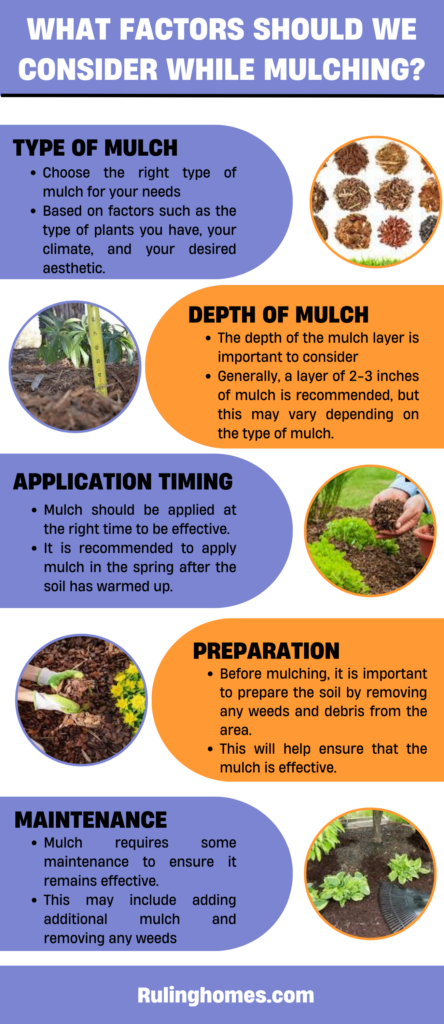Mulch is a material that is spread over the soil surface around plants and trees.
Mulch helps to create a healthy growing environment for plants, which can result in improved plant growth and reduced maintenance needs.
Here are the few main functions of what mulch can do:
Retains moisture: The best mulch helps to retain moisture in the soil by reducing evaporation from the soil surface. This is especially important during hot and dry weather conditions.
Suppresses weeds: Mulch helps to suppress the growth of weeds by blocking their access to sunlight.
This reduces the competition between the plants and the weeds for water and nutrients, which can help to improve plant growth.
Regulates soil temperature: Mulch helps to regulate soil temperature by acting as an insulator.
This means that it keeps the soil warmer in colder weather and cooler in hotter weather.
This can help to prevent temperature fluctuations that can stress the plants.
Prevents erosion: Mulch helps to prevent erosion by holding the soil in place. This is especially important on slopes where soil erosion can be a problem.
Adds nutrients to the soil: Some types of organic mulch, such as compost, can add nutrients to the soil as they break down. This can help to improve soil fertility and plant growth.
Enhances soil structure: Organic mulch can help to improve soil structure by increasing soil organic matter and promoting the growth of beneficial microorganisms.
This can improve soil aeration and drainage, which can benefit plant growth.
How many cubic feet in a yard of mulch?
A cubic yard is a unit of volume that is equal to 27 cubic feet. Therefore, to determine the number of cubic feet in a yard of mulch, you simply need to multiply the number of yards by 27.
Here’s a step-by-step guide to calculating the number of cubic feet in a yard of mulch:
Step 1
Determine the volume of the mulch pile in cubic yards. This can be done by measuring the length, width, and height of the pile in yards and then multiplying these dimensions together.
For example, if the pile is 3 yards long, 2 yards wide, and 1 yard high, then the volume would be 3 x 2 x 1 = 6 cubic yards.
Step 2
Multiply the volume of the mulch pile in cubic yards by 27.
For example, if the volume of the mulch pile is 6 cubic yards, then the number of cubic feet in the pile would be 6 x 27 = 162 cubic feet.
What factors should we consider while mulching?
Here are some important considerations to keep in mind while mulching:
Type of Mulch: There are different types of mulch available, including organic and inorganic options.
It is important to choose the right type of mulch for your needs based on factors such as the type of plants you have, your climate, and your desired aesthetic.
Depth of Mulch: The depth of the mulch layer is important to consider because it can impact the effectiveness of the mulch.
Generally, a layer of 2-3 inches of mulch is recommended, but this may vary depending on the type of mulch and the plants you have.
Application Timing: Mulch should be applied at the right time to be effective.
It is recommended to apply mulch in the spring after the soil has warmed up, but before weeds have had a chance to germinate.
Mulch can also be applied in the fall to help protect plants during the winter months.
Preparation: Before mulching, it is important to prepare the soil by removing any weeds and debris from the area.
This will help ensure that the mulch is effective and does not provide a growing environment for weeds.
Maintenance: Mulch requires some maintenance to ensure it remains effective.
This may include adding additional mulch to maintain the desired depth, removing any weeds that manage to grow through the mulch layer, and occasionally turning or fluffing the mulch to prevent compaction.
Conclusion
In conclusion, mulching is an effective and beneficial practice for gardeners and landscapers.
It helps to retain soil moisture, suppress weeds, regulate soil temperature, prevent erosion, add nutrients to the soil, and enhance soil structure.
By considering important factors such as the type of mulch, depth of mulch, timing of application, preparation, and maintenance, gardeners and landscapers can reap the full benefits of mulching.
Mulching is an easy and affordable way to improve plant growth and reduce maintenance needs, making it a valuable addition to any gardening or landscaping project.

I grew up on a small farm in New Jersey. We had a big family because my parents, my uncles and aunties all were living together on this farm so, you can imagine, it was always over crowded with people. But living in farm was really great because we had to do everything on our own and I learned so many things from my parents and uncles and aunties and that is where I found my passion for fixing things, whether it is renovating or designing, I was always there. Read more

